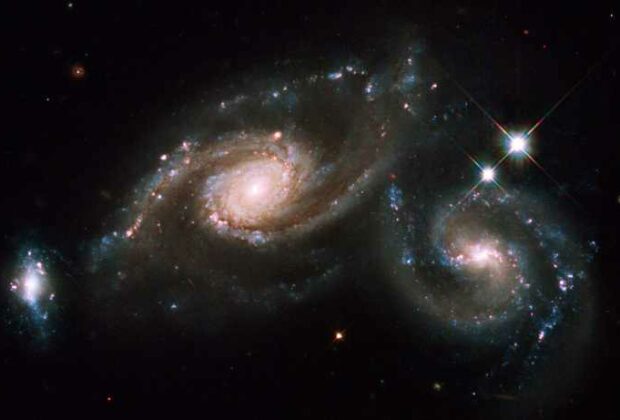A recent Hubble Space Telescope image of two merging galaxies shows active star creation.
The spiral galaxies that are part of Arp 300, UGC 05028 and UGC 05029, are merging right now. According to a NASA release, the smaller galaxy (UGC 05028), sometimes referred to as interacting or colliding galaxies, has been pulled and bent by the strong gravitational field of its larger companion (UGC 05029).
“Likely due to its gravitational dance with its larger partner, UGC 05028 has an asymmetric, irregular structure, which is not as visible from ground-based telescopes but is quite distinct in this new image from NASA’s Hubble Space Telescope,” the release stated.
Both galaxies appear face-on from Hubble’s perspective, so the new image makes their luminous core bulges and spiral arms evident. A spiral galaxy appears round and disc-shaped when viewed face-on, but it looks different when viewed from the side, or edge-on. They appear more oval-shaped and crushed in the later position. Below the galaxy UGC 05029, near the bottom of the new Hubble image, is another example of an edge-on galaxy.
Southeast of its core, UGC 05028 displays a brilliant knot that could be the product of another ongoing galactic merger. Scientists predict that after the merger is finished, UGC 05028 will completely swallow the remnant of the other galaxy, forming a noticeable central bulge like to UGC 05029 and promoting the production of new stars.
This kind of event leads to the rapid star creation seen in UGC 05029. As seen by the numerous bright, blue massive stars on UGC 05029’s spiral arms closest to its companion UGC 05028, the contact between the two merging galaxies has sped up star creation.
In order to gain a deeper understanding of the relationship between the physical properties of UGC 05028 and UGC 05029 and the processes of their star creation, Hubble shifted its focus to Arp 300. In the process, NASA released an image on January 22 that shows a grouping of five distant background galaxies near the bottom of the image, among other objects in the galactic neighbourhood that were also photographed by the space telescope.








